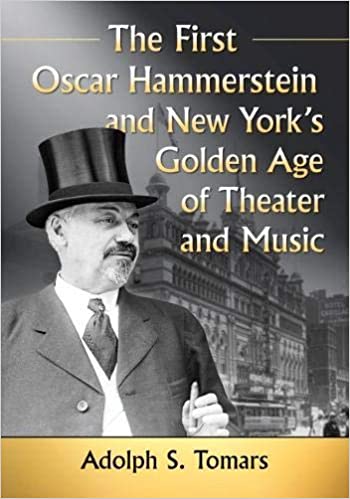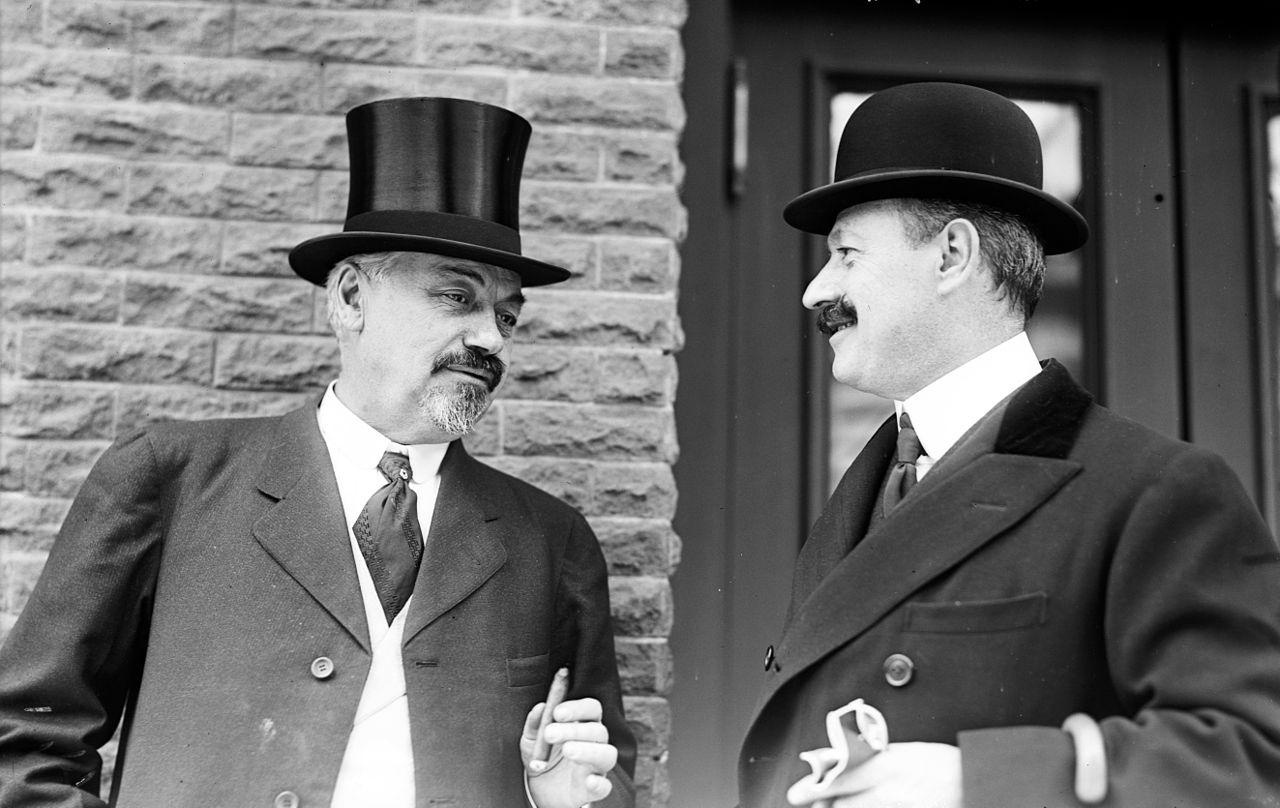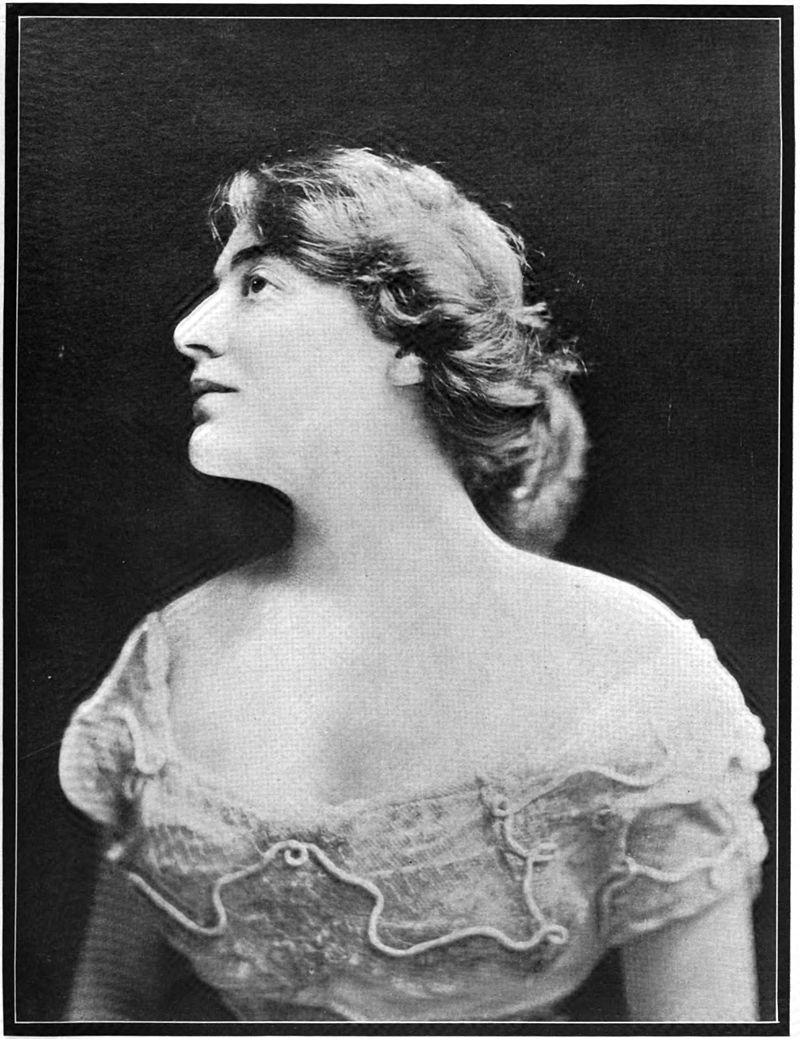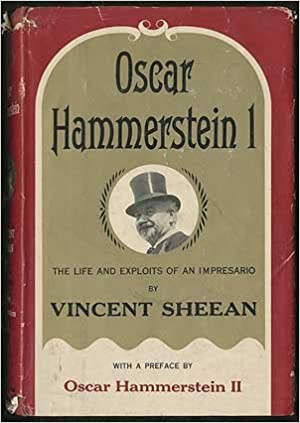Richard C. Norton
Operetta Research Center
20 May, 2020
With such an irresistible title as this, anyone with an interest in early American musical theater would want to read this newly published volume. However, the author, sociologist Adolph S. Tomars (1908-1985), left this manuscript unpublished at the time of his death. Its rediscovery and publication today, thanks to his daughter Adrea Tomars Nairne, some forty-five years later, is long overdue.

The book cover “The First Oscar Hammerstein and New York’s Golden Age of Theater and Music” published by McFarland.
The titular hero, Oscar Hammerstein I, is a familiar American archetype, the self-made immigrant who made and lost several fortunes in real estate, commercial theatre and grand opera. Arguably unscrupulous, charismatic and demanding, he manipulated the tabloid press and public with enviable skill. Hammerstein relished risk-taking and confrontation. He possessed a knack for turning adversity upside down and manipulating facts like a certain twenty-first century American president!
Author Adolph S. Tomars’ research is the result of a life-long fascination with grand opera, aided by a foundation grant he received in 1959. His father, Semion Tomars, worked for Oscar Hammerstein I as a stage manager at the Manhattan Opera House (1908) and Hammerstein’s London Opera House (1912-13).
No doubt Semion Tomars’ many recollections inspired his son. But this book’s title is misleading, as its text is narrowly limited to three years (1893-1896) of Hammerstein’s exploits in New York City’s colorful theatre history. Hammerstein’s battle with his partners/rivals Koster & Bial, his stunt/wager he could write a comic opera by himself sequestered for 48 hours, his building of Hammerstein’s Olympia Theatre complex at Broadway & 43-44th Streets, are recounted in exuberant detail. His shrewd business acumen determined the mix of the highbrow (grand opera, comic opera, classical ballet) and the lowbrow (music hall, vaudeville, minstrelsy, burlesque) despite his personal preference for grand opera.

East side of Longacre Square (today called Times Square), at 44th Street, with Hammerstein’s Olympia entertainment complex occupying the blockfront from 44th to 45th Streets. (Photo: Museum of the City of New York)
Hammerstein introduced to America the French music hall diseuse Yvette Guilbert, quick change artist Leopoldo Fregoli, each whom get a chapter of their own. Equally fascinating is the presumed cultural superiority of anyone/anything European or British over home-grown American talents, and Hammerstein’s skillful exploitation of this prejudice, snobbery and provincialism.

Oscar Hammerstein I (left) with conductor Cleofonte Campanini in New York, 1908. (Photo: United States Library of Congress)
Oh for the biography Tomars might have written! His is a breezy, readable, colloquial style filled with an abundance of personalities and anecdotes, as if you were reading the newspapers and magazines of the day. The New York Clipper and Dramatic Mirror, the New York Tribune, the New York Herald, New York Mirror and New York World are much quoted and frequently referred to. Tomars’ book offers an entrepreneurial account, but no scholarly insight into Hammerstein’s talents or skill as composer and librettist of The Kohinoor, the one act comic opera he composed on a dare (1893), or his spectacular opera/ballet Marguerite (1896). Tomars’ opening chapter ‘Mr. Show Business’ offers an impressive list of the noted opera stars Hammerstein presented; celebrity and fame yes, but he is scant on insight or details. The author holds his hero in such awe and admiration, the reader may rightly wonder at what price such sycophancy.
What of Hammerstein’s German origins, education, emigration, early success in the tobacco business? None of these are addressed. What of his first two theatres built in Harlem, the Harlem Opera House (1889) or the Columbus (1890)? Visionary or folly? Hammerstein’s bankruptcy in 1898? Why no illustration for Hammerstein’s first Manhattan Opera House at 135 West 34th St (1892-1901), later Koster & Bial’s, whose story takes up Chapters 2-6? This should not to be confused with the second Manhattan Opera House (1906) at 311 West 34th Street.

Hammerstein’s Victoria Theatre was opened on March 3, 1899 by theatre baron Oscar Hammerstein. The Victoria Theatre also had a roof garden which abutted The Republic Theatre.
Tomars credits Hammerstein’s imagination in constructing the Olympia’s three venues in one structure north of Longacre Square (1895) for what later became New York’s Times Square. But there’s no mention of the Victoria Theatre (1899), Hammerstein’s rivalry and many confrontations with the Metropolitan Opera Co, nor their buying him out for $ 1.2 million (1910), his failure in London 1912-13? What of his family, wives? What of his two indispensable sons: operetta producer Arthur Hammerstein (1872-1955) and Willie Hammerstein (1875-1914, father to the famed music theatre librettist Oscar Hammerstein II)? His daughters, Stella and Rose? There are great stories here to be told.

Stella Hammerstein, an actress and daughter of Oscar Hammerstein I. (Photo from “New York Star,” 1908)
For all of this detail, Tomars is regrettably silent, and one must turn to an earlier biography by Vincent Sheean from 1956, Oscar Hammerstein I: The Life and Exploits of an Impresario (Simon & Schuster, 1956, 364 pages). Oscar Hammerstein’s II’s heart-breaking preface to Sheean’s volume offers a tantalizing clue to Oscar I’s estrangement from his own family.

The cover of “Oscar Hammerstein I: The Life and Exploits of an Impresario”.
Given these many omissions, the lack of footnotes identifying source materials all evidently bequeathed to New York City Public Library, the few public domain illustrations added as an afterthought, and the narrow three-year time frame of Tomars’ volume, I’d recommend the reader consider the ebook format ($ 15.39), as it is less of an investment than the paperback edition ($ 45.00).
For theatre historians, George C. Odell’s indispensable fifteen volume set, Annals of the New York Stage, begins in 1750 and ends in 1894. Much to the credit of Adolph S. Tomars, his ‘new’ volume picks up where Odell ends, and fills a welcome gap in the history of the popular New York stage.
Perhaps Tomars’ belated biography of OH1 should be viewed as a coda to Odell, and a reply to Sheean’s work of 1956. Despite these reservations, it’s great fun to read. I only wish the author had completed the book he set out to write, perhaps at three times the length and depth.

Thank you for your review of my father’s book. As noted, the period covered is limited but represents perhaps the most exciting part of musical theater history. I am happy you enjoyed his writing and your comment that this was long overdue is so true.
There are more pages and groups of writings as well as notes and clippings but these 500 typed pages were in tact and I couldn’t let them just sit in a drawer.
There may be more to come in the future but for now, his work is out there as it should be..
Adrea Tomars Nairne